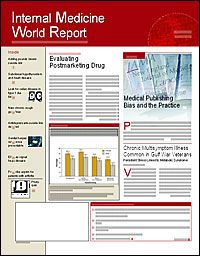Publication
Article
Internal Medicine World Report
Hormone Changes Explain High Asthma Rates in Women
Author(s):
From the American College of Allergy, Asthma & Immunology
ANAHEIM, Calif?Hormone fluctuations resulting from life cycle changes may explain the greater incidence of asthma and more frequent emergency department visits and higher hospital admission rates in women compared with men, according to data presented at the annual meeting of the American College of Allergy, Asthma & Immunology.
Although among children aged <12 years, asthma is more prevalent in boys than in girls, the trend reverses around pu?berty, when asthma becomes more common in girls. Among adults, asthma is 3 times more common in women than in men.
Women in their reproductive years (ages 20-50) are >3 times more likely than men to be hospitalized with asthma, despite comparable spirometry values, noted Nancy Ostrom, MD, of the University of California, San Diego. "Studies have demonstrated a relationship between asthma and the menstrual cycle, with 46% of women's hospital admissions being perimenstrual, and up to 40% of women having premenstrual asthma symptoms," she said.
Obesity, sedentary lifestyle, and smoking are additional factors that potentially contribute to the gender differences observed in asthma morbidity and mortality.
Women with asthma have more symptoms during the premenstrual and menstrual weeks, with peak symptoms at 2 to 3 days before menses. "Many asthmatic women are not aware of this pattern, and keeping a diary of their symptoms is helpful," advised Joan Gluck, MD, of the Florida Center for Allergy and Asthma Care in Miami.
About 30% of women with asthma suffer from pre?menstrual asthma, and most of them respond to standard therapy; how?ever, others need more inhaled corticosteroids or long-acting beta agonist therapy on days 19 to 24 of their cycles, said Dr Gluck. In a small subset of women who are unresponsive to standard therapy, oral contraceptives are beneficial, because added progesterone and estrogen strengthen airway muscles and relax smooth-muscle tissue.
"Nonasthmatic women taking oral contraceptives have a higher total lung capacity. Airways are more stable in women with asthma who take oral contraceptives, and several small studies have shown their asthma does improve," said Dr Gluck.
Higher asthma rates have also been observed in menopausal and perimeno?pausal women.
"Some of these women get really sick," Dr Gluck told IMWR.
The reason for this is the low estrogen and progesterone levels in women with asthma, which drop even further during these later years. Dr Gluck said these hormones usually suppress the normal immune reactions, and the low hormone levels during menopause contribute to asthma flare-ups.
Therefore, hormone replacement therapy (HRT) has relevance to the management of asthma. Women without asthma who take HRT are at increased risk of developing asthma. Asthmatic women who take HRT experience significant improvements in their asthma symptoms, with studies showing as much as a 35% reduction in the use of inhaled steroids, explains Dr Gluck.
"All those studies that came out saying hormone replacement therapy was dangerous did a great disservice to these women, because if they don't take it, their asthma becomes very serious and hard to control," said Dr Gluck. "This needs to be higher on the ?physician's radar screen. It is being missed a lot."






